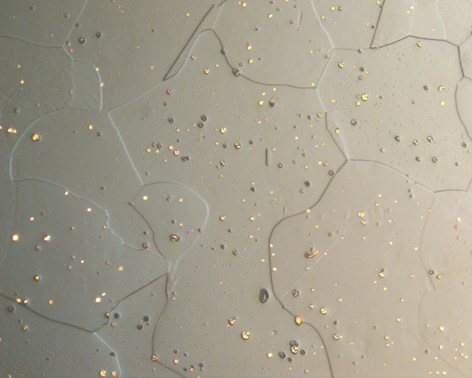



Metallographic experiment report of Cu-12Sn
2022-11-08
Tin bronze is bronze with tin as the main alloying element. In addition to containing 3% to 14% tin, elements such as phosphorus, zinc, and lead are often added. It is the earliest alloy used by humans and has been used for about 4,000 years. It is corrosion-resistant, wear-resistant, has good mechanical properties and process properties, and can be welded and brazed well, does not produce sparks when impacted. Due to its soft texture, it is easy to produce a deep deformation layer during metallographic preparation, which brings trouble to polishing and corrosion. Especially in the annealed state, the grains grow and the internal dislocation density decreases. It is impossible to efficiently prepare its metallographic phase using the traditional mechanical polishing method, and chemical-mechanical polishing method should be used instead.
01 Equipment and consumables
| Equipment | Trojan Alpha-202 manual grinder&polisher; Trojan ThetaMount pressure cold mounting machine; MN 60 series microscope; Air blower; |
| Consumables | degreasing cotton;φ30mm silicone mold; Trojan TJ2562AB epoxy resin; |
02 Preparation process
1-Mounting
After ultrasonic cleaning of the specimens, prepare TJ2562AB epoxy resin in proportion to mounting the specimen, and then place the specimens in Trojan ThetaMount pressure cold mounting machine for mounting under pressure.
| Equipment | ThetaMount pressure cold mounting machine |
| Consumables | TJ2562AB epoxy resin |
| Parameter | Resin:hardener=3:1,time12h |
2-Grinding
Polish the specimen with Alpha-202 manual grinder&polisher,abrasive paper P1200→P2500.
| Equipment | Alpha-202 double disc grinder&polisher |
| Consumables | Abrasive paper:P1200→P2500 |
| Parameter | 300rpm |
3.1-Polishing(plane polishing)
Polish the specimen with Alpha-202 grinder&polisher,use YS polishing cloth with 3μm polycrystalline diamond suspension for plane polishing. Note to add PL-W polishing lubricant for polishing.
|
| Equipment | Alpha-202 double disc double control grinder&polisher |
| Consumables | YS polishing cloth,3μm polycrystalline diamond suspension,PL-W polishing lubricant | |
|
| Parameter | Speed:500rpm,time:5min~10min |
3.2-Polishing(fine polishing)
Polish the specimen with Alpha-202 grinder&polisher,use FR polishing cloth with 0.05μm non-crystallizing silica suspension for fine polishing.(Add 25% ammonia water and 3% hydrogen peroxide to the non-crystallizing silica suspension)
| Equipment | Alpha-202 double disc double control grinder&polisher |
| Consumables | Final Red polishing cloth,0.05μm non-crystallizing silica suspension |
| Parameter | Speed:200rpm,time is subject to availability |
4- Corrosion
In practice, it was found that the reaction between the aqueous solution of ferric chloride hydrochloric acid and the sample was relatively intense. For this reason, 50% alcohol was added as a corrosion inhibitor, so that the corrosion process could be well controlled, and the dripping method was used. In addition, the mixed solution of ammonia water and hydrogen peroxide can also be used as a corrosive agent, and its properties are relatively mild.
| Reagent | formula | Instructions |
| Aqueous solution of ferric chloride hydrochloric acid | FeCl₃ 3ml | Drip etching |
5-Observation
| Equipment | MN 60 series microscope |
| Consumables | |
| Parameter | 50×→500× |
03 Analysis

Cu-12Sn 50×
Grain boundaries are clearly visible

Cu-12Sn 50×
Visible twinning and residual dendrite shadows in some grains

Cu-12Sn 50×
There are a lot of black dots inside the grains and grain boundaries

Cu-12Sn polarized light 50×
Under polarized light, some black dots can be seen with a "black cross" phenomenon, which is presumed to be silica inclusions
Cu-12Sn alloy is an annealed sample, and its hardness is low, and it is easy to produce a deep deformation layer during grinding and polishing. Therefore, when grinding, you should start with fine sandpaper as much as possible. The strength of manual grinding must be light, and each sandpaper should ensure that the deformation layer produced by the previous sandpaper is removed.
When polishing, the deformed layer produced by grinding should be removed in the rough polishing stage. For this purpose, coarser polishing particles can be used on the hardness woven cloth and carried out for a longer time. Use with lubricant.
For fine polishing, use a soft, short-pile polishing cloth for chemical polishing to remove the deformed layer and scratches caused by rough polishing.
It is unrealistic to obtain a perfect sample by one time of grinding, polishing and etching. Repeated polishing-etching operations are required under limited conditions. That is, after the scratches appear in the corrosion, the last mechanochemical polishing is performed again and then the etching is performed again, and this step is repeated until there are no scratches.
During fine polishing, the speed can be adjusted in the range of 150~300rpm, the speed is fast at the beginning, and the low speed is used at the end. The pressure on the hand should be light, and at the same time do the reverse rotation movement with the chassis.
Etched with mild etchants, using the drip etch method.
The black spots in the metallographic phase are silica and silicate inclusions.